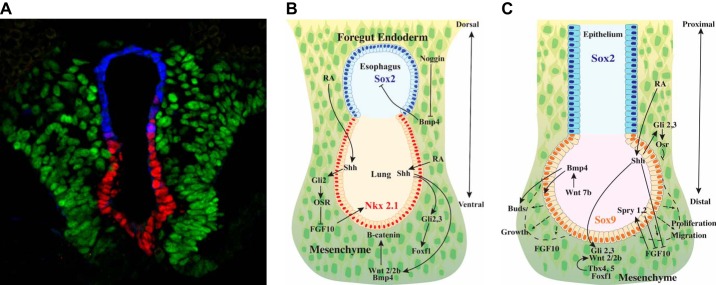FIGURE 6.
Differentiation of the embryonic foregut endoderm. A: foregut endodermal cells respond to bone morphogenetic protein 4 (BMP4), sonic hedgehog (SHH), and fibroblast growth factor (FGF) signaling along the dorsal-ventral axis of the common esophageal (SOX2 in blue) and lung (NKX2–1 in red) tubules. The tubules migrate into the splanchnic mesenchyme (FOXF1 in green). B: Noggin, from the notochord, inhibits BMP4, maintaining SOX2 expression in esophageal cells. Retinoic acid mediates SHH signaling that activates Gli2/3 in the splanchnic mesenchyme, activating Wnt2/2b and BMP4 that maintains NKX2–1 expression in the epithelium required for lung specification. Maintenance of the lung bud requires FGF10 produced by the mesenchyme and β-catenin signaling in the epithelium that regulate the patterning of the mesenchyme (green) and the epithelium (red). C: complex paracrine signaling regulates branching morphogenesis. During the embryonic to canalicular periods of lung development, respiratory epithelial cells migrate and proliferate as airways and peripheral acini are formed. Epithelial cells from the peripheral lung buds proliferate and migrate in response to FGF10 gradients produced by the mesenchyme that are counterregulated by Spry1,2 to limit proliferation. FGF, WNT, SHH, and BMP signaling regulates growth and patterning of the lung buds in a transcriptional network by which ETV5 regulates SHH in the epithelium, activating Gli2/3, FoxF1, and TBX proteins in the mesenchyme, to control expression of Wnt2/2b and FGF-10. Retinoic acid influences SHH and renders the endoderm responsive to NKX2–1. After separation of trachea and esophagus, SOX2 is re-expressed in conducting airways. SOX9 marks peripheral acinar cells that ultimately differentiate into AT1 and AT2 cells to form the alveoli. (A courtesy of Dr. Aaron Zorn, used with permision.)

